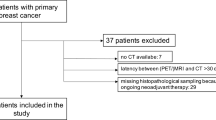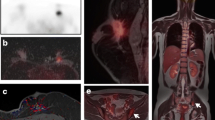Abstract
Objective
To evaluate the performance of 18F-fluorodeoxyglucose (FDG) positron emission tomography magnetic resonance imaging (PET/MR) for preoperative breast cancer staging.
Methods
Preoperative PET/MR exams of 58 consecutive women with breast cancer were retrospectively reviewed. Histology and mean follow-up of 26 months served as gold standard. Four experienced readers evaluated primary lesions, lymph nodes and distant metastases with contrast-enhanced MRI, qualitative/quantitative PET, and combined PET/MR. ROC curves were calculated for all modalities and their combinations.
Results
The study included 101 breast lesions (83 malignant, 18 benign) and 198 lymph node groups, (34 malignant, 164 benign). Two patients had distant metastases. Areas under the curve (AUC) for breast cancer were 0.9558, 0.8347 and 0.8855 with MRI, and with qualitative and quantitative PET/MR, respectively (p = 0.066). Sensitivity for primary cancers with MRI and quantitative PET/MR was 100 % and 77 % (p = 0.004), and for lymph nodes 88 % and 79 % (p = 0.25), respectively. Specificity for MRI and PET/MR for primary cancers was 67 % and 100 % (p = 0.03) and for lymph nodes 98 % and 100 % (p = 0.25).
Conclusions
In breast cancer patients, MRI alone has the highest sensitivity for primary tumours. For nodal metastases, both MRI and PET/MR are highly specific.
Key points
• MRI alone and PET/MR have a similar overall diagnostic performance.
• MRI alone has a higher sensitivity than PET/MR for local tumour assessment.
• Both MRI and PET/MR have a limited sensitivity for nodal metastases.
• Positive lymph nodes on MRI or PET/MR do not require presurgical biopsy.





Similar content being viewed by others
Abbreviations
- 18-FDG-:
-
18F-fluorodeoxyglucose
- PET/MR:
-
Positron emission tomography combined with magnetic resonance imaging
- SUV:
-
Standard Uptake Value
- PET/CT:
-
Positron emission tomography/computed tomography
- SUVmax:
-
Maximum SUV corrected for time
- SUVratio:
-
Ratio of the breast lesions SUVmax to the SUVmax of the healthy breast parenchyma
- NAC:
-
Neoadjuvant chemotherapy
- ALND:
-
Axillary lymph node dissection
- ROC curves:
-
Receiver operating characteristic curves
- AUC:
-
Area under the curve
- PPV:
-
Positive predictive value
- NPV:
-
Negative predictive value
References
Houssami N, Ciatto S, Macaskill P et al (2008) Accuracy and surgical impact of magnetic resonance imaging in breast cancer staging: systematic review and meta-analysis in detection of multifocal and multicentric cancer. J Clin Oncol 26:3248–3258
Heywang-Kobrunner SH, Hacker A, Sedlacek S (2013) Magnetic resonance imaging: the evolution of breast imaging. Breast 22:S77–S82
Pinker K, Bogner W, Baltzer P et al (2014) Improved diagnostic accuracy with multiparametric magnetic resonance imaging of the breast using dynamic contrast-enhanced magnetic resonance imaging, diffusion-weighted imaging, and 3-dimensional proton magnetic resonance spectroscopic imaging. Investig Radiol 49:421–430
Bernardi D, Ciatto S, Pellegrini M, Valentini M, Houssami N (2012) EUSOMA criteria for performing preoperative MRI staging in candidates for breast conserving surgery: hype or helpful? Breast 21:406–408
Knuttel FM, Menezes GL, van den Bosch MA, Gilhuijs KG, Peters NH (2014) Current clinical indications for magnetic resonance imaging of the breast. J Surg Oncol 110:26–31
Sardanelli F, Boetes C, Borisch B et al (2010) Magnetic resonance imaging of the breast: recommendations from the EUSOMA working group. Eur J Cancer 46:1296–1316
Peters NH, van Esser S, van den Bosch MA et al (2011) Preoperative MRI and surgical management in patients with nonpalpable breast cancer: the MONET - randomised controlled trial. Eur J Cancer 47:879–886
Turnbull L, Brown S, Harvey I et al (2010) Comparative effectiveness of MRI in breast cancer (COMICE) trial: a randomised controlled trial. Lancet 375:563–571
Menezes GL, Knuttel FM, Stehouwer BL, Pijnappel RM, van den Bosch MA (2014) Magnetic resonance imaging in breast cancer: a literature review and future perspectives. World J Clin Oncol 5:61–70
Lee SC, Jain PA, Jethwa SC, Tripathy D, Yamashita MW (2014) Radiologist's role in breast cancer staging: providing key information for clinicians. Radiographics 34:330–342
Kvistad KA, Rydland J, Smethurst HB, Lundgren S, Fjosne HE, Haraldseth O (2000) Axillary lymph node metastases in breast cancer: preoperative detection with dynamic contrast-enhanced MRI. Eur Radiol 10:1464–1471
Cardoso F, Costa A, Norton L et al (2014) ESO-ESMO 2nd international consensus guidelines for advanced breast cancer (ABC2). Breast 23:489–502
Gradishar WJ, Anderson BO, Blair SL et al (2014) Breast cancer version 3.2014. J Natl Compr Cancer Netw 12:542–590
Kim J, Lee J, Chang E et al (2009) Selective sentinel node plus additional non-sentinel node biopsy based on an FDG-PET/CT scan in early breast cancer patients: single institutional experience. World J Surg 33:943–949
Ueda S, Tsuda H, Asakawa H et al (2008) Utility of 18F-fluoro-deoxyglucose emission tomography/computed tomography fusion imaging (18F-FDG PET/CT) in combination with ultrasonography for axillary staging in primary breast cancer. BMC Cancer 8:165
Bellevre D, Blanc Fournier C, Switsers O et al (2014) Staging the axilla in breast cancer patients with (1)(8)F-FDG PET: how small are the metastases that we can detect with new generation clinical PET systems? Eur J Nucl Med Mol Image 41:1103–1112
Vinh-Hung V, Everaert H, Lamote J et al (2012) Diagnostic and prognostic correlates of preoperative FDG PET for breast cancer. Eur J Nucl Med Mol Image 39:1618–1627
Groheux D, Giacchetti S, Espie M et al (2011) The yield of 18F-FDG PET/CT in patients with clinical stage IIA, IIB, or IIIA breast cancer: a prospective study. J Nucl Med 52:1526–1534
Bernsdorf M, Berthelsen AK, Wielenga VT et al (2012) Preoperative PET/CT in early-stage breast cancer. Ann Oncol 23:2277–2282
Groheux D, Moretti JL, Baillet G et al (2008) Effect of (18)F-FDG PET/CT imaging in patients with clinical Stage II and III breast cancer. Int J Radiat Oncol Biol Phys 71:695–704
Hausmann D, Kern C, Schroder MT et al (2011) Whole-body MRI in preoperative diagnostics of breast cancer—a comparison with [corrected] staging methods according to the S 3 guidelines. RöFo 183:1130–1137
Schmidt GP, Baur-Melnyk A, Haug A et al (2008) Comprehensive imaging of tumour recurrence in breast cancer patients using whole-body MRI at 1.5 and 3 T compared to FDG-PET-CT. Eur J Radiol 65:47–58
Dietzel M, Zoubi R, Burmeister HP, Runnebaum IB, Kaiser WA, Baltzer PA (2012) Combined staging at one stop using MR mammography: evaluation of an extended protocol to screen for distant metastasis in primary breast cancer - initial results and diagnostic accuracy in a prospective study. RoFo Fortschritte auf dem Gebiete der Rontgenstrahlen und der Nuklearmedizin 184:618–623
Vargas MI, Becker M, Garibotto V et al (2013) Approaches for the optimization of MR protocols in clinical hybrid PET/MRI studies. MAGMA 26:57–69
Kalemis A, Delattre BM, Heinzer S (2013) Sequential whole-body PET/MR scanner: concept, clinical use, and optimisation after two years in the clinic. The manufacturer's perspective. MAGMA 26:5–23
D’Orsi CJSE, Mendelson EB, Morris EA et al (2013) ACR BI-RADS® ATLAS breast imaging reporting and data system. American College of Radiology, Reston, VA
Baltzer PA, Kaiser WA, Dietzel M (2015) Lesion type and reader experience affect the diagnostic accuracy of breast MRI: a multiple reader ROC study. Eur J Radiol 84:86–91
Baltzer PA, Dietzel M, Burmeister HP et al (2011) Application of MR mammography beyond local staging: is there a potential to accurately assess axillary lymph nodes? evaluation of an extended protocol in an initial prospective study. Am J Roentgenol 196:W641–W647
Riedl CC, Slobod E, Jochelson M et al (2014) Retrospective analysis of 18F-FDG PET/CT for staging asymptomatic breast cancer patients younger than 40 years. J Nucl Med 55:1578–1583
Laffon E, de Clermont H, Marthan R (2011) A method of adjusting SUV for injection-acquisition time differences in (18)F-FDG PET imaging. Eur Radiol 21:2417–2424
Tabouret-Viaud C, Botsikas D, Delattre BM et al (2015) PET/MR in breast cancer. Semin Nucl Med 45:304–321
Pace L, Nicolai E, Luongo A et al (2014) Comparison of whole-body PET/CT and PET/MRI in breast cancer patients: lesion detection and quantitation of 18F-deoxyglucose uptake in lesions and in normal organ tissues. Eur J Radiol 83:289–296
Taneja S, Jena A, Goel R, Sarin R, Kaul S (2014) Simultaneous whole-body F-FDG PET-MRI in primary staging of breast cancer: a pilot study. Eur J Radiol 83:2231–9
Bitencourt AG, Lima EN, Chojniak R et al (2014) Multiparametric evaluation of breast lesions using PET-MRI: initial results and future perspectives. Medicine 93:e115
Bitencourt AG, Lima EN, Chojniak R et al (2014) Can 18F-FDG PET improve the evaluation of suspicious breast lesions on MRI? Eur J Radiol 83:1381–1386
Byun BH, Noh WC, Lim I et al (2013) A new method for apparent diffusion coefficient measurement using sequential (18)F-FDG PET and MRI: correlation with histological grade of invasive ductal carcinoma of the breast. Ann Nucl Med 27:720–728
Pinker K, Bogner W, Baltzer P et al (2014) Improved differentiation of benign and malignant breast tumours with multiparametric 18fluorodeoxyglucose positron emission tomography magnetic resonance imaging: a feasibility study. Clin Cancer Res 20:3540–3549
Donker M, van Tienhoven G, Straver ME et al (2014) Radiotherapy or surgery of the axilla after a positive sentinel node in breast cancer (EORTC 10981-22023 AMAROS): a randomised, multicentre, open-label, phase 3 non-inferiority trial. Lancet Oncol 15:1303–1310
Giuliano AE, Hunt KK, Ballman KV et al (2011) Axillary dissection vs no axillary dissection in women with invasive breast cancer and sentinel node metastasis: a randomized clinical trial. J Am Med Assoc 305:569–575
Lyman GH, Temin S, Edge SB et al (2014) Sentinel lymph node biopsy for patients with early-stage breast cancer: American society of clinical oncology clinical practice guideline update. J Clin Oncol 32:1365–1383
Acknowledgments
The scientific guarantor of this publication is Diomidis BOTSIKAS. The authors of this manuscript declare no relationships with any companies, whose products or services may be related to the subject matter of the article. The authors state that this work has not received any funding. One of the authors has significant statistical expertise. No complex statistical methods were necessary for this paper. Institutional Review Board approval was obtained. Written informed consent was obtained from all subjects (patients) in this study.
Methodology: retrospective, diagnostic or prognostic study, performed at one institution.
Author information
Authors and Affiliations
Corresponding author
Ethics declarations
Conflict of interest
The authors declare no conflict of interest.
Rights and permissions
About this article
Cite this article
Botsikas, D., Kalovidouri, A., Becker, M. et al. Clinical utility of 18F-FDG-PET/MR for preoperative breast cancer staging. Eur Radiol 26, 2297–2307 (2016). https://doi.org/10.1007/s00330-015-4054-z
Received:
Revised:
Accepted:
Published:
Issue Date:
DOI: https://doi.org/10.1007/s00330-015-4054-z




